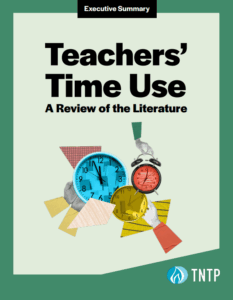Great teaching is priceless. After all, you can’t put a figure on the value of sparking a child’s love of reading, or making a whole room of students feel safe taking risks—and we all know nobody goes into teaching to get rich. But teaching is a profession, after all—one of our most important—and the truth is that the way we currently pay teachers in this country doesn’t even come close to the true value of great teaching.
Today, we’re putting a stake in the ground on teacher pay. In our new paper, Shortchanged: The Hidden Costs of Lockstep Teacher Pay, we argue that the standard mode of compensating teachers—based on years of experience and advanced degrees—is shortchanging our best educators, hurting our students and degrading the teaching profession. Lockstep pay simply doesn’t build the profession we want. Consider just a few of the consequences:
It makes it hard to recruit top talent. Starting salaries for teachers are around 25 percent less than those for professionals in fields like marketing, nursing or accounting, and it can take decades for teachers to reach the top of the salary scale. How many outstanding young people do you know who wouldn’t even think about teaching as a career because they are turned off by the pay?
It pushes great teachers out of the classroom—and encourages ineffective teachers to stay. No matter how much great teachers excel at their jobs, they are never recognized with anything more than the same small raise that every other teacher receives—even those who put forth far less effort and whose students demonstrate far less impressive results. What teacher hasn’t felt deflation and frustration upon realizing that within the same building, salaries for teaching positions vary widely… and some of the weakest practitioners often take home the largest checks, merely because they’ve been taking them home for the longest time?
It discourages high performers from teaching in the schools that need them most. Great teachers should be encouraged—and rewarded—for teaching in high-poverty schools, but most compensation systems treat every teaching assignment the same. Who hasn’t had a conversation with a colleague who is thinking about transferring to a school perceived as having fewer challenges? And how many of those colleagues would consider sticking with their current school if they were truly compensated for the complexity of their work?
Not only that, but lockstep teacher pay costs districts dearly. You might be surprised to learn, as we were, that school districts across the country spend an estimated $250 million on raises for their least effective teachers—and that’s a conservative estimate. Lockstep pay actually rewards low performers for staying. That’s just the beginning. We estimate that districts also spend $8.5 billion a year on pay bumps for master’s degrees alone—even though advanced degrees have been shown to have little to no impact on teachers’ effectiveness with students.
But aren’t years of service and advanced degrees the only “fair” criteria on which to base teacher salaries? Teaching is a complex field, after all.
We think that precisely because teaching is so complex, it’s imperative that we find a way to pay teachers for what really matters: how hard their jobs are, and how well they do them. In fact, we think that while lockstep teacher pay is undeniably preferable to some teachers who gain substantial benefits from it, it is fundamentally unfair to great teachers and to students.
It’s time to build smarter compensation systems that pay great teachers what they’re really worth, by focusing on higher starting salaries, pay bumps for strong classroom performance, and incentives for great teachers in high-need schools. As a nation, we say we believe in the value of great teaching, but sadly, today’s pay system says we think teachers are widgets and excellence doesn’t matter. It’s time to put our money where our mouths are.
It can be done. Districts like Newark Public Schools and District of Columbia Public Schools are using performance-based compensation systems to attract great teachers and then treat them with the respect they’re due, as highly skilled professionals worthy of competitive compensation. They’re seeing promising results—in D.C., dissatisfaction with compensation has become one of the least common reasons highly effective teachers cite for leaving the district.
Other places, like Achievement First charter network, are linking compensation with roles and responsibilities for teachers based on their effectiveness with students. And in Louisiana, Indiana, Tennessee and Florida, state laws are pushing local districts to find their own ways to link performance and teacher pay. Together, these school systems offer a roadmap for how to pay great teachers for the incredible value they bring.
That’s our two cents, so to speak. We aren’t saying we have it all figured out. We don’t believe compensation should be entirely based on bonuses or be unstable from year to year. But we think lockstep pay is a mess and the case for change is increasingly hard to ignore.
What do you think is the best way to approach teacher pay? Read the paper and share your thoughts with us.








